new posts in all blogs
Viewing: Blog Posts Tagged with: 2016 poetry, Most Recent at Top [Help]
Results 1 - 5 of 5
How to use this Page
You are viewing the most recent posts tagged with the words: 2016 poetry in the JacketFlap blog reader. What is a tag? Think of a tag as a keyword or category label. Tags can both help you find posts on JacketFlap.com as well as provide an easy way for you to "remember" and classify posts for later recall. Try adding a tag yourself by clicking "Add a tag" below a post's header. Scroll down through the list of Recent Posts in the left column and click on a post title that sounds interesting. You can view all posts from a specific blog by clicking the Blog name in the right column, or you can click a 'More Posts from this Blog' link in any individual post.
 Fun Fact: The American Library Association does not currently give an award specifically to great works of children’s book poetry. Is not that strange? When I first discovered this to be true, I was perplexed. I’ve always been a bit of a rube when it comes to the poetic form. Placing stresses on syllables and knowing what constitutes a sestina and all that. Of course even without its own award specifically, poetry can win the Newbery or the Caldecott. Yet too often when it happens it’s in the form of a verse novel or its sort of pooh-poohed for its win. Remember when Last Stop on Market Street won the Newbery and folks were arguing that it was the first picture book to do so since A Visit to William’s Blake’s Inn couldn’t possibly be considered a picture book because it was poetry? None of this is to say that poetry doesn’t win Newberys (as recently as 2011 Dark Emperor and Other Poems of the Night by Joyce Sidman won an Honor) but aside from the month of April (Poetry Month a.k.a. the only time the 811 section of the public library is sucked dry) poetry doesn’t get a lot of attention.
Fun Fact: The American Library Association does not currently give an award specifically to great works of children’s book poetry. Is not that strange? When I first discovered this to be true, I was perplexed. I’ve always been a bit of a rube when it comes to the poetic form. Placing stresses on syllables and knowing what constitutes a sestina and all that. Of course even without its own award specifically, poetry can win the Newbery or the Caldecott. Yet too often when it happens it’s in the form of a verse novel or its sort of pooh-poohed for its win. Remember when Last Stop on Market Street won the Newbery and folks were arguing that it was the first picture book to do so since A Visit to William’s Blake’s Inn couldn’t possibly be considered a picture book because it was poetry? None of this is to say that poetry doesn’t win Newberys (as recently as 2011 Dark Emperor and Other Poems of the Night by Joyce Sidman won an Honor) but aside from the month of April (Poetry Month a.k.a. the only time the 811 section of the public library is sucked dry) poetry doesn’t get a lot of attention.
So rather than relegate all poetry discussions to April, let us today celebrate some of the lovelier works of poetry out for kids this year. Because we lucked out, folks. 2016 was a great year for verse:
2016 Poetry Books for Kids
Are You an Echo?: The Lost Poetry of Misuzu Kaneko by David Jacobson, ill. Toshikado Hajiri, translations by Sally Ito and Michiko Tsuboi
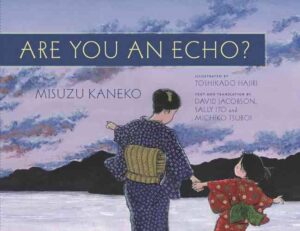
No surprises here. If you know me then you know I’m gaga for this title. For the purposes of today’s list, however, let’s just zero in on Kaneko’s own poetry. Cynical beast that I am, I would sooner eat my own tongue than use a tired phrase like “childlike wonder” to describe something. And yet . . . I’m stuck. Honestly there’s no other way to adequately convey to you what Kaneko has done so perfectly with this book. Come for the biography and history lesson. Stay for the incomparable poems.
Freedom Over Me: Eleven Slaves, Their Lives and Dreams Brought to Life by Ashley Bryan

I’m not entirely certain that I can express in words how deeply satisfying it’s been to see this book get as much love and attention as it has, so far. Already its appeared on Chicago Public Library’s Best of the Best, its been a Kirkus Prize Finalist, it was on the NCTE Notable Poetry List, and New York Public Library listed it on their Best Books for Kids. I would have liked to add an Image Award nomination in there as well, but you don’t always get what you want. Regardless, I maintain my position that this is a serious Newbery contender. Even if it misses out during the January award season, there is comfort in knowing that folks are finding it. Very satisfying.
Grumbles From the Town: Mother-Goose Voices With a Twist by Jane Yolen and Rebecca Kai Dotlich, ill. Angela Matteson

Its been promoted as a writing prompt book, but I’d argue that the poetry in this collection stands on its own two feet as well. Yolen and Dotlich take classic nursery rhymes and twist them. We’ve all seen that kind of thing before, but I like how they’ve twisted them. A passing familiarity with the original poetry a good idea, though they’ve covered their bases and included that information in the back of the book as well. Good original fun all around.
Jazz Day: The Making of a Famous Photograph by Roxane Orgill, ill. Francis Vallejo

So far it’s won the only major award (aside from the Kirkus prize) to be released so far for a 2016 title. Jazz Day took home the gold when it won in the picture book category of the Boston Globe-Horn Book Awards. And, granted, I was on that committee, but I wasn’t the only one there. It’s such an amazing book, and aside from poetry its hard to slot it into any one category. Fiction or nonfiction? You be the judge.
Miss Muffet, Or What Came After by Marilyn Singer, ill. David Litchfield

It’s sort of epic. From one single short little nursery rhyme, Singer spins out this grandiose tale of crushed hopes, impossible dreams, and overcoming arachnophobia. Since it’s a story told in rhyme I’m sort of cheating, putting it on this poetry list. Maybe it’s more school play than poetry book. I say, why not be both?
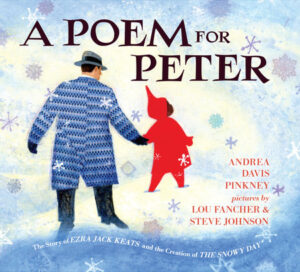
Now this book has been nominated for an NAACP Image Award, so there is some justice in this world. When I first read the description I wasn’t entirely certain how it would work. Imagine the daunting task of telling Ezra Jack Keats’ story using his own illustration style. Imagine too the difficulty that comes with using poetry and verse to tell the details of his story. Pinkney’s done poetry of one sort or another before, but I dare say this is her strongest work to date in that style.
Slickety Quick: Poems About Sharks by Skila Brown, ill. Bob Kolar
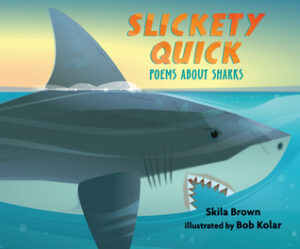
From the start I liked the poems (they were smart) but since it was about real sharks I pondered that question every children’s librarian knows so well: how would it fly with kids? Well, I donated a copy to my kid’s daycare and found, to my infinite delight, that the kids in that class were CRAZY about it. Every day when I went to pick my daughter up, she and the other kids would start telling me shark facts. You’ve gotta understand that these were four-year-olds telling me this stuff. If they get such a kick out of the book (and they do) imagine how the older kids might feel!
A Toucan Can, Can You? by Danny Adlerman, ill. Various
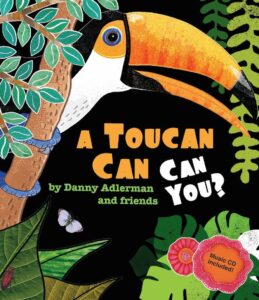
It’s baaaaack. Yeah, this little self-published gem keeps cropping up on my lists. Someone recently asked me where they could purchase it, since it’s not available through the usual streams. I think you can get it here, in case you’re curious. And why should you be curious? Because it takes that old How Much Wood Could a Woodchuck Chuck, expands it, and then gets seriously great illustrators to contribute. A lovely book.
Somo Como Las Nubes / We Are Like the Clouds by Jorge Argueta, ill. Elisa Amado
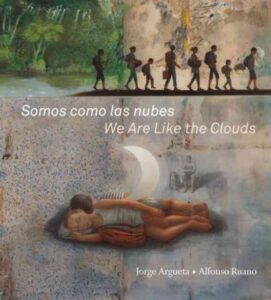
Because to be perfectly frank, your shelves aren’t exactly exploding with books about refugee children from South America. That said, it’s easy to include books on lists of this sort because their intentions are good. It’s another thing entirely when the book itself actually is good. Argueta is an old hand at this. You can trust him to do a fantastic job, and this book is simultaneously necessary and expertly done. There’s a reason I put it on my bilingual book list as well.
Spinach Dip Pancakes by Kevin Kammeraad, ill. Danny Adlerman, Kim Adlerman, Chris Fox, Alynn Guerra, Justin Haveman, Ryan Hipp, Stephanie Kammeraad, Carlos Kammeraad, Maria Kammeraad, Steve Kammeraad, Linda Kammeraad, Laurie Keller, Scott Mack, Ruth McNally Barshaw, Carolyn Stich, Joel Tanis, Corey Van Duinen, Aaron Zenz, & Rachel Zylstra
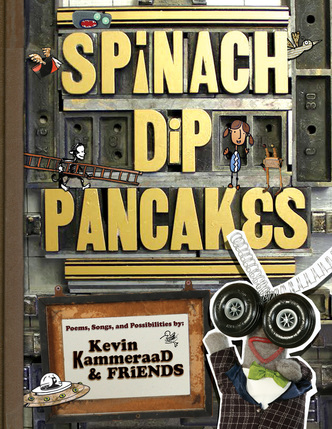
This book bears not a small number of similarities to the aforementioned Toucan Can book. The difference, however, is that these are all original little tiny poems put into a book illustrated by a huge range of different illustrators. The poems are funny and original and the art eclectic, weird, wise and wonderful. It even comes with a CD of performances of the poems. Want a taste? Then I am happy to premiere a video that is accompanying this book. The video cleverly brings to life the poem “Game”. I think you’ll get a kick out of it. And then be unable to remove it from your brain (good earworm, this).
If you liked that, check out the book’s book trailer and behind-the-scenes peek as well.
Wet Cement: A Mix of Concrete Poems by Bob Raczka
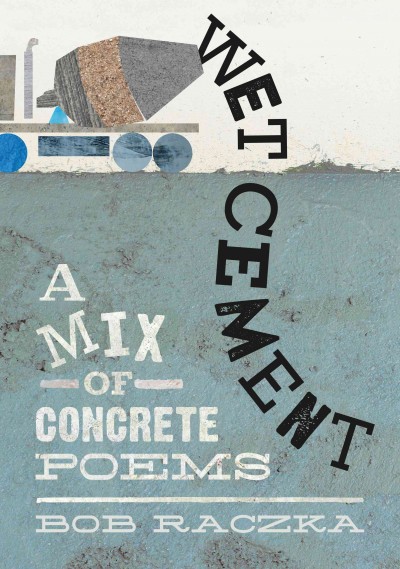
My year is not complete unless I am able to work a Raczka poetry collection onto a list. I’m very partial to this one. It’s a bit graphic design-y and a bit clever as all get out. Here’s my favorite poem of the lot:
Poetry is about taking away the words you don’t need
poetry is taking away words you don’t need
poetry is words you need
poetry is words
try
When Green Becomes Tomatoes: Poems for All Seasons by Julie Fogliano, ill. Julie Morstad

I think I broke more than a few hearts when I told people that Morstad’s Canadian status meant the book was ineligible for a Caldecott. At least you can take comfort in the fact that the poetry is sublime. I think we’ve all seen our fair share of seasonal poems. They’re not an original idea, yet Fogliano makes them seem new. This collection actually bears much in common with the poetry of the aforementioned Misuzu Kaneko. I think she would have liked it.
You Can Fly: The Tuskegee Airmen by Carole Boston Weatherford, ill. Jeffery Boston Weatherford
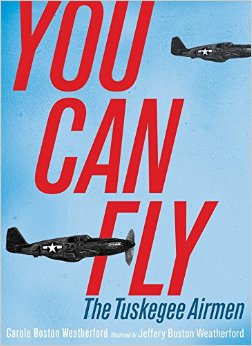
It’s poetry and a kind of verse novel as well. I figured I should include one in today’s list, though I’d argue that the verse here serves the poems better than the storyline. There is a storyline, of course, but I like the poetry for its own sake. My favorite in the book? The one about Lena Horne. I had no idea the personal sacrifices she made during WWII. There’s a picture book bio coming out about her in 2017, by the way. Looks like I’ll need to know more.
Interested in the other lists of the month? Here’s the schedule so that you can keep checking back:
December 1 – Board Books
December 2 – Board Book Adaptations
December 3 – Nursery Rhymes
December 4 – Picture Book Readalouds
December 5 – Rhyming Picture Books
December 6 – Alphabet Books
December 7 – Funny Picture Books
December 8 – Calde-Nots
December 9 – Picture Book Reprints
December 10 – Math Picture Books
December 11 – Bilingual Books
December 12 – International Imports
December 13 – Books with a Message
December 14 – Fabulous Photography
December 15 – Fairy Tales / Folktales
December 16 – Oddest Books of the Year
December 17 – Older Picture Books
December 18 – Easy Books
December 19 – Early Chapter Books
December 20 – Graphic Novels
December 21 – Poetry
December 22 – Fictionalized Nonfiction
December 23 – American History
December 24 – Science & Nature Books
December 25 – Transcendent Holiday Titles
December 26 – Unique Biographies
December 27 – Nonfiction Picture Books
December 28 – Nonfiction Chapter Books
December 29 – Novel Reprints
December 30 – Novels
December 31 – Picture Books


By:
Betsy Bird,
on 10/5/2016
Blog:
A Fuse #8 Production
(
Login to Add to MyJacketFlap)
JacketFlap tags:
Misuzu Kaneko,
Best Books of 2016,
2016 reviews,
Reviews 2016,
2016 poetry,
2016 picture book biographies,
David Jacobson,
Michiko Tsuboi,
Toshikado Hajiri,
Reviews,
poetry,
Best Books,
picture book biographies,
Sally Ito,
funny poetry,
middle grade poetry,
Add a tag
 Are You an Echo? The Lost Poetry of Misuzu Kaneko
Are You an Echo? The Lost Poetry of Misuzu Kaneko
Narrative and Translation by David Jacobson, Sally Ito, and Michiko Tsuboi
Illustrated by Toshikado Hajiri
Chin Music Press
$19.50
ISBN: 9781634059626
Ages 5 and up
On shelves now
Recently I was at a conference celebrating the creators of different kinds of children’s books. During one of the panel discussions an author of a picture book biography of Fannie Lou Hamer said that part of the mission of children’s book authors is to break down “the canonical boundaries of biography”. I knew what she meant. A cursory glance at any school library or public library’s children’s room will show that most biographies go to pretty familiar names. It’s easy to forget how much we need biographies of interesting, obscure people who have done great things. Fortunately, at this conference, I had an ace up my sleeve. I knew perfectly well that one such book has just been published here in the States and it’s a game changer. Are You an Echo? The Lost Poetry of Misuzu Kaneko isn’t your typical dry as dust retelling of a life. It crackles with energy, mystery, tragedy, and, ultimately, redemption. This book doesn’t just break down the boundaries of biography. It breaks down the boundaries placed on children’s poetry, art, and translation too. Smarter and more beautiful than it has any right to be, this book challenges a variety of different biography/poetry conventions. The fact that it’s fun to read as well is just gravy.
Part biography, part poetry collection, and part history, Are You an Echo? introduces readers to the life and work of celebrated Japanese poet Misuzu Kaneko. One day a man by the name of Setsuo Yazaki stumbled upon a poem called “Big Catch”. The poet’s seemingly effortless ability to empathize with the plight of fish inspired him to look into her other works. The problem? The only known book of her poems out there was caught in the conflagration following the firebombing of Tokyo during World War II. Still, Setsuo was determined and after sixteen years he located the poet’s younger brother who had her diaries, containing 512 of Misuzu’s poems. From this, Setsuo was able to piece together her life. Born in 1902, Misuzu Kaneko grew up in Senzaki in western Japan. She stayed in school at her mother’s insistence and worked in her mother’s bookstore. For fun she submitted some of her poems to a monthly magazine and shockingly every magazine she submitted them to accepted them. Yet all was not well for Misuzu. She had married poorly, contracted a disease from her unfaithful husband that caused her pain, and he had forced her to stop writing as well. Worst of all, when she threatened to leave he told her that their daughter’s custody would fall to him. Unable to see a way out of her problem, she ended her life at twenty-six, leaving her child in the care of her mother. Years passed, and the tsunami of 2011 took place. Misuzu’s poem “Are You an Echo?” was aired alongside public service announcements and it touched millions of people. Suddenly, Misuzu was the most famous children’s poet of Japan, giving people hope when they needed it. She will never be forgotten again. The book is spotted with ten poems throughout Misuzu’s story, and fifteen additional poems at the end.
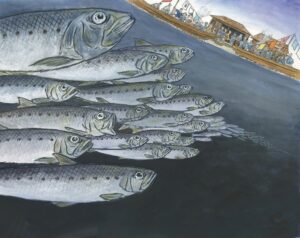 There’s been a lot of talk in the children’s literature sphere about the role of picture book biographies. More specifically, what’s their purpose? Are they there simply to inform and delight or do they need to actually attempt to encapsulate the great moments in a person’s life, warts and all? If a picture book bio only selects a single moment out of someone’s life as a kind of example, can you still call it a biography? If you make up dialogue and imagine what might have happened in one scene or another, do those fictional elements keep it from the “Biography” section of your library or bookstore, or is there a place out there for fictionalized bios? These questions are new ones, just as the very existence of picture book biographies, in as great a quantity as we’re seeing them, is also new. One of the takeaways I’ve gotten from these conversations is that it is possible to tackle difficult subjects in a picture book bio, but it must be done naturally and for a good reason. So a story like Gary Golio’s Spirit Seeker can discuss John Coltrane’s drug abuse, as long as it serves the story and the character’s growth. On the flip side, Javaka Steptoe’s Radiant Child, a biography of Basquiat, makes the choice of discussing the artist’s mother’s fight with depression and mental illness, but eschews any mention of his own suicide.
There’s been a lot of talk in the children’s literature sphere about the role of picture book biographies. More specifically, what’s their purpose? Are they there simply to inform and delight or do they need to actually attempt to encapsulate the great moments in a person’s life, warts and all? If a picture book bio only selects a single moment out of someone’s life as a kind of example, can you still call it a biography? If you make up dialogue and imagine what might have happened in one scene or another, do those fictional elements keep it from the “Biography” section of your library or bookstore, or is there a place out there for fictionalized bios? These questions are new ones, just as the very existence of picture book biographies, in as great a quantity as we’re seeing them, is also new. One of the takeaways I’ve gotten from these conversations is that it is possible to tackle difficult subjects in a picture book bio, but it must be done naturally and for a good reason. So a story like Gary Golio’s Spirit Seeker can discuss John Coltrane’s drug abuse, as long as it serves the story and the character’s growth. On the flip side, Javaka Steptoe’s Radiant Child, a biography of Basquiat, makes the choice of discussing the artist’s mother’s fight with depression and mental illness, but eschews any mention of his own suicide.
Are You An Echo? is an interesting book to mention alongside these two other biographies because the story is partly about Misuzu Kaneko’s life, partly about how she was discovered as a poet, and partly a highlight of her poetry. But what author David Jacobson has opted to do here is tell the full story of her life. As such, this is one of the rare picture book bios I’ve seen to talk about suicide, and probably the only book of its kind I’ve ever seen to make even a passing reference to STDs. Both issues informed Kaneko’s life, depression, feelings of helplessness, and they contribute to her story. The STD is presented obliquely so that parents can choose or not choose to explain it to kids if they like. The suicide is less avoidable, so it’s told in a matter-of-fact manner that I really appreciated. Euphemisms, for the most part, are avoided. The text reads, “She was weak from illness and determined not to let her husband take their child. So she decided to end her life. She was only twenty-six years old.” That’s bleak but it tells you what you need to know and is honest to its subject.
 But let’s just back up a second and acknowledge that this isn’t actually a picture book biography in the strictest sense of the term. Truthfully, this book is rife, RIFE, with poetry. As it turns out, it was the editorial decision to couple moments in Misuzu’s life with pertinent poems that gave the book its original feel. I’ve been wracking my brain, trying to come up with a picture book biography of a poet that has done anything similar. I know one must exist out there, but I was hard pressed to think of it. Maybe it’s done so rarely because the publishers are afraid of where the book might end up. Do you catalog this book as poetry or as biography? Heck, you could catalog it in the Japanese history section and still be right on in your assessment. It’s possible that a book that melds so many genres together could only have been published in the 21st century, when the influx of graphic inspired children’s literature has promulgated. Whatever the case, reading this book you’re struck with the strong conviction that the book is as good as it is precisely because of this melding of genres. To give up this aspect of the book would be to weaken it.
But let’s just back up a second and acknowledge that this isn’t actually a picture book biography in the strictest sense of the term. Truthfully, this book is rife, RIFE, with poetry. As it turns out, it was the editorial decision to couple moments in Misuzu’s life with pertinent poems that gave the book its original feel. I’ve been wracking my brain, trying to come up with a picture book biography of a poet that has done anything similar. I know one must exist out there, but I was hard pressed to think of it. Maybe it’s done so rarely because the publishers are afraid of where the book might end up. Do you catalog this book as poetry or as biography? Heck, you could catalog it in the Japanese history section and still be right on in your assessment. It’s possible that a book that melds so many genres together could only have been published in the 21st century, when the influx of graphic inspired children’s literature has promulgated. Whatever the case, reading this book you’re struck with the strong conviction that the book is as good as it is precisely because of this melding of genres. To give up this aspect of the book would be to weaken it.
Right off the bat I was impressed by the choice of poems. The first one you encounter is called “Big Catch” and it tells about a village that has caught a great number of fish. The poem ends by saying, “On the beach, it’s like a festival / but in the sea they will hold funerals / for the tens of thousands dead.” The researcher Setsuo Yazaki was impressed by the poet’s empathy for the fish, and that empathy is repeated again and again in her poems. “Big Catch” is actually one of her bleaker works. Generally speaking, the poems look at the world through childlike eyes. “Wonder” contemplates small mysteries, in “Beautiful Town” the subject realizes that a memory isn’t from life but from a picture in a borrowed book, and “Snow Pile” contemplates how the snow on the bottom, the snow on the top, and the snow in the middle of a pile must feel when they’re all pressed together. The temptation would be to call Kaneko the Japanese Emily Dickenson, owing to the nature of the discovery of her poems posthumously, but that’s unfair to both Kaneko and Dickenson. Kenko’s poems are remarkable not just because of their original empathy, but also because they are singularly childlike. A kid would get a kick out of reading these poems. That’s no mean feat.
 Mind you, we’re dealing with a translation here. And considering how beautifully these poems read, you might want a note from the translators talking about their process. You can imagine, then, how thrilled I was to find a half-page’s worth of a “Translators’ Note” explaining aspects of the work here that never would have occurred to me in a million years. The most interesting problem came down to culture. As Sally Ito and Michiko Tsuboi write, “In Japanese, girls have a particular way of speaking that is affectionate and endearing . . . However, English is limited in its capacity to convey Misuzu’s subtle feminine sensibility and the elegant nuances of her classical allusions. We therefore had to skillfully work our way through both languages, often producing several versions of a poem by discussing them on Skype and through extensive emails – Michiko from Japan, Sally from China – to arrive at the best possible translations in English.” It makes a reader really sit back and admire the sheer levels of dedication and hard work that go into a book of this sort. If you read this book and find that the poems strike you as singularly interesting and unique, you may now have to credit these dedicated translators as greatly as you do the original subject herself. We owe them a lot.
Mind you, we’re dealing with a translation here. And considering how beautifully these poems read, you might want a note from the translators talking about their process. You can imagine, then, how thrilled I was to find a half-page’s worth of a “Translators’ Note” explaining aspects of the work here that never would have occurred to me in a million years. The most interesting problem came down to culture. As Sally Ito and Michiko Tsuboi write, “In Japanese, girls have a particular way of speaking that is affectionate and endearing . . . However, English is limited in its capacity to convey Misuzu’s subtle feminine sensibility and the elegant nuances of her classical allusions. We therefore had to skillfully work our way through both languages, often producing several versions of a poem by discussing them on Skype and through extensive emails – Michiko from Japan, Sally from China – to arrive at the best possible translations in English.” It makes a reader really sit back and admire the sheer levels of dedication and hard work that go into a book of this sort. If you read this book and find that the poems strike you as singularly interesting and unique, you may now have to credit these dedicated translators as greatly as you do the original subject herself. We owe them a lot.
In the back of the book there is a note from the translators and a note from David Jacobson who wrote the text of the book that didn’t include the poetry. What’s conspicuously missing here is a note from the illustrator. That’s a real pity too since biographical information about artist Toshikado Hajiri is missing. Turns out, Toshikado is originally from Kyoto and now lives in Anan, Tokushima. Just a cursory glance at his art shows a mild manga influence. You can see it in the eyes of the characters and the ways in which Toshikado chooses to draw emotions. That said, this artist is capable of also conveying great and powerful moments of beauty in nature. The sunrise behind a beloved island, the crush of chaos following the tsunami, and a peach/coral/red sunset, with a grandmother and granddaughter silhouetted against its beauty. What Toshikado does here is match Misuzu’s poetry, note for note. The joyous moments she found in the world are conveyed visually, matching, if never exceeding or distracting from, her prowess. The end result is more moving than you might expect, particularly when he includes little human moments like Misuzu reading to her daughter on her lap or bathing her one last time.
Here is what I hope happens. I hope that someday soon, the name “Misuzu Kaneko” will become better known in the United States. I hope that we’ll start seeing collections of her poems here, illustrated by some of our top picture book artists. I hope that the fame that came to Kaneko after the 2011 tsunami will take place in America, without the aid of a national disaster. And I hope that every child that reads, or is read, one of her poems feels that little sense of empathy she conveyed so effortlessly in her life. I hope all of this, and I hope that people find this book. In many ways, this book is an example of what children’s poetry should strive to be. It tells the truth, but not the truth of adults attempting to impart wisdom upon their offspring. This is the truth that the children find on their own, but often do not bother to convey to the adults in their lives. Considering how much of this book concerns itself with being truthful about Misuzu’s own life and struggles, this conceit matches its subject matter to a tee. Beautiful, mesmerizing, necessary reading for one and all.
On shelves now.
Source: Final copy sent from publisher for review.
Like This? Then Try:
Misc: An article in PW about the translation.


By:
Betsy Bird,
on 6/29/2016
Blog:
A Fuse #8 Production
(
Login to Add to MyJacketFlap)
JacketFlap tags:
picture book poetry,
African-American authors and illustrators,
Best Books of 2016,
2016 reviews,
Reviews 2016,
2016 poetry,
Reviews,
history,
poetry,
Simon and Schuster,
Atheneum,
Best Books,
Ashley Bryan,
multicultural children's literature,
African-American history,
Add a tag
 Freedom Over Me: Eleven slaves, their lives and dreams brought to life
Freedom Over Me: Eleven slaves, their lives and dreams brought to life
By Ashley Bryan
Atheneum (an imprint of Simon & Schuster)
$17.99
ISBN: 978-1481456906
Ages 9 and up
On shelves September 13th
Who gives voice to the voiceless? What are your credentials when you do so? When I was a teen I used to go into antique stores and buy old family photographs from the turn of the century. It still seems odd to me that this is allowed. I’d find the people who looked the most interesting, like they had a story to tell, and I’d take them home with me. Then I’d write something about their story, though mostly I just liked to look at them. There is a strange comfort in looking at the faces of the fashionable dead. A little twinge of momento mori mixed with the knowledge that you yourself are young (possibly) and alive (probably). It’s easy to hypothesize about a life when you can see that person’s face and watch them in their middle class Sunday best. It is far more difficult when you have no face, a hint of a name, and/or maybe just an age. Add to this the idea that the people in question lived through a man made hell-on-earth. When author/illustrator/artist Ashley Bryan acquired a collection of slave-related documents from the 1820s to the 1860s he had in his hands a wealth of untold stories. And when he chose to give these people, swallowed by history, lives and dignity and peace, he did so as only he could. With the light and laughter and beauty that only he could find in the depths of uncommon pain. Freedom Over Me is a work of bravery and sense. A way of dealing with the unimaginable, allowing kids an understanding that there is a brain, heart, and soul behind every body, alive or dead, in human history.
The date on the Fairchilds Appraisement is July 5, 1828. On it you will find a list of goods to be sold. Cows, hogs, cotton . . . and people. Eleven people, if we’re going to be precise (and we are). Most have names. One does not. Just names on a piece of paper almost 200-years-old. So Ashley Bryan, he takes those names and those people, and for the first time in centuries we get to meet them. Here is Athelia, a laundress who once carried the name Adero. On one page we hear about her life. On the next, her dreams. She remembers the village she grew up in, the stories, and the songs. And she is not alone in this. As we meet each person and learn what they do, we get a glimpse into their dreams. We hear their hopes. We wonder about their lives. We see them draw strength from one another. And in the end? The sale page sits there. The final words: “Administered to the best of our Judgment.”
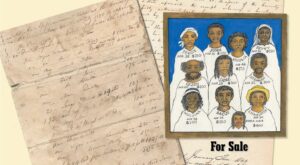 I have often said, and I say it to this day, that if there were ever a Church of Ashley Bryan, every last person who has ever met him or heard him speak would be a member. There are only a few people on this great green Earth that radiant actual uncut goodness right through their very pores. Mr. Bryan is one of those few, so when I asked at the beginning of this review what the credentials are for giving voice to the voiceless, check off that box. There are other reasons to trust him, though. A project of this sort requires a certain level of respect for the deceased. To attain that, and this may seem obvious, the author has to care. Read enough books written for kids and you get a very clear sense of those books written by folks who do not care vs. folks that do. Even then, caring’s not really enough. The writing needs to be up to speed and the art needs to be on board. And for this particular project, Ashley Bryan had a stiffer task at hand. Okay. You’ve given them full names and backgrounds and histories. What else do they need? Bryan gives these people something intangible. He gives them dreams. It’s right there in the subtitle, actually: “Eleven slaves, their lives and dreams brought to life.”
I have often said, and I say it to this day, that if there were ever a Church of Ashley Bryan, every last person who has ever met him or heard him speak would be a member. There are only a few people on this great green Earth that radiant actual uncut goodness right through their very pores. Mr. Bryan is one of those few, so when I asked at the beginning of this review what the credentials are for giving voice to the voiceless, check off that box. There are other reasons to trust him, though. A project of this sort requires a certain level of respect for the deceased. To attain that, and this may seem obvious, the author has to care. Read enough books written for kids and you get a very clear sense of those books written by folks who do not care vs. folks that do. Even then, caring’s not really enough. The writing needs to be up to speed and the art needs to be on board. And for this particular project, Ashley Bryan had a stiffer task at hand. Okay. You’ve given them full names and backgrounds and histories. What else do they need? Bryan gives these people something intangible. He gives them dreams. It’s right there in the subtitle, actually: “Eleven slaves, their lives and dreams brought to life.”
And so the book is a work of fiction. There is no amount of research that could discover Bacus or Peggy or Dora’s true tales. So when we say that Bryan is giving these people their lives back, we acknowledge that the lives he’s giving them aren’t the exact lives they led. And so we know that each person is a representative above and beyond the names on that page. Hence the occupations. Betty is every gardener. Stephen every architect. Dora every child that was born to a state of slavery and labored under it, perhaps their whole lives. And there is very little backmatter included in this book. Bryan shows the primary documents alongside a transcription of the sales. There is also an Author’s Note. Beyond that, you bring to the book what you already know about slavery, making this a title for a slightly older child readership. Bryan isn’t going to spend these pages telling you every daily injustice of slavery. Kids walk in with that knowledge already in place. What they need now is some humanity.
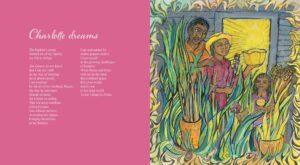 Has Mr. Bryan ever done anything with slavery before? I was curious. I’ve watched Mr. Bryan’s books over the years and they are always interesting. He’s done spirituals as cut paper masterpieces. He’s originated folktales as lively and quick as their inspirational forbears. He makes puppets out of found objects that carry with them a feeling not just of dignity, but pride. But has he ever directly done a book that references slavery? So I examined his entire repertoire, from the moment he illustrated Black Boy by Richard Wright to Susan Cooper’s Jethro and the Jumbie to Ashley Bryan’s African Folktales, Uh-Huh and beyond. His interest in Africa and song and poetry knows no bounds, but never has he engaged so directly with slavery itself.
Has Mr. Bryan ever done anything with slavery before? I was curious. I’ve watched Mr. Bryan’s books over the years and they are always interesting. He’s done spirituals as cut paper masterpieces. He’s originated folktales as lively and quick as their inspirational forbears. He makes puppets out of found objects that carry with them a feeling not just of dignity, but pride. But has he ever directly done a book that references slavery? So I examined his entire repertoire, from the moment he illustrated Black Boy by Richard Wright to Susan Cooper’s Jethro and the Jumbie to Ashley Bryan’s African Folktales, Uh-Huh and beyond. His interest in Africa and song and poetry knows no bounds, but never has he engaged so directly with slavery itself.
Could this have been done as anything but poetry? Or would you even call each written section poetry? I would, but I’ll be interested to see where libraries decide to shelve the book. Do you classify it as poetry or in the history section under slavery? Maybe, for all that it seems to be the size and shape of a picture book, you’d put it in your fiction collection. Wherever you put it, I am reminded, as I read this book, of Good Masters! Sweet Ladies! where every lord and peasant gets a monologue from their point of view. Freedom Over Me bears more than a passing similarity to Good Masters. In both cases we have short monologues any kid could read aloud in class or on their own. They are informed by research, and their scant number of words speak to a time we’ll never really know or understand fully. And how easy it would be to turn this book into a stage play. I can see it so easily. Imagine if you turned the Author’s Note into the first monologue and Ashley Bryan his own character (behold the 10-year-old dressed up as him, mustache and all). Since the title of the book comes from the spiritual “Oh, Freedom!” you could either have the kids sing it or play it in the background. And for the ending? A kid playing the lawyer or possibly Mrs. Fairchilds or even Ashley comes out and reads the statement at the end with each person and their price and the kids step forward holding some object that defines them (clothing sewn, books read, paintings, etc.). It’s almost too easy.
 The style of the art was also interesting to me. Pen, ink, and watercolors are all Mr. Bryan (who is ninety-two years of age, as of this review) needs to render his people alive. I’ve see him indulge in a range of artistic mediums over the years. In this book, he begins with an image of the estate, an image of the slaves on that estate, and then portraits and renderings of each person, at rest or active in some way. “Peggy” is one of the first women featured, and for her portrait Ashley gives her face whorls and lines, not dissimilar to those you’d find in wood. This technique is repeated, to varying degrees, with the rest of the people in the book. First the portrait. Then an image of what they do in their daily lives or dreams. The degree of detail in each of these portraits changes a bit. Peggy, for example, is one of the most striking. The colors of her skin, and the care and attention with which each line in her face is painted, make it clear why she was selected to be first. I would have loved the other portraits to contain this level of detail, but the artist is not as consistent in this regard. Charlotte and Dora, for example, are practically line-less, a conscious choice, but a kind of pity since Peggy’s portrait sets you up to think that they’ll all look as richly detailed and textured as she.
The style of the art was also interesting to me. Pen, ink, and watercolors are all Mr. Bryan (who is ninety-two years of age, as of this review) needs to render his people alive. I’ve see him indulge in a range of artistic mediums over the years. In this book, he begins with an image of the estate, an image of the slaves on that estate, and then portraits and renderings of each person, at rest or active in some way. “Peggy” is one of the first women featured, and for her portrait Ashley gives her face whorls and lines, not dissimilar to those you’d find in wood. This technique is repeated, to varying degrees, with the rest of the people in the book. First the portrait. Then an image of what they do in their daily lives or dreams. The degree of detail in each of these portraits changes a bit. Peggy, for example, is one of the most striking. The colors of her skin, and the care and attention with which each line in her face is painted, make it clear why she was selected to be first. I would have loved the other portraits to contain this level of detail, but the artist is not as consistent in this regard. Charlotte and Dora, for example, are practically line-less, a conscious choice, but a kind of pity since Peggy’s portrait sets you up to think that they’ll all look as richly detailed and textured as she.
Those old photographs I once collected may well be the only record those people left of themselves on this earth, aside from a name in a family tree and perhaps on a headstone somewhere. So much time has passed since July 5, 1828 that it is impossible to say whether or not the names on Ashley’s acquired Appraisement are remembered by their descendants. Do families still talk about Jane or Qush? Is this piece of paper the only part of them that remains in the world? It may not have been the lives they led, but Ashley Bryan does everything within his own personal capacity to keep these names and these people alive, if just for a little longer. Along the way he makes it clear to kids that slaves weren’t simply an unfortunate mass of bodies. They were architects and artists and musicians. They were good and bad and human just like the rest of us. Terry Pratchett once wrote that sin is when people treat other people as objects. Ashley treats people as people. And times being what they are, here in the 21st century I’d say that’s a pretty valuable lesson to be teaching our kids today.
On shelves September 13th.
Source: Galley sent from publisher for review.
Like This? Then Try:
Professional Reviews: A star from Kirkus
Misc: Interested in the other books Mr. Bryan has written or illustrated over the course of his illustrious career? See the full list on his website here.


By:
Betsy Bird,
on 3/23/2016
Blog:
A Fuse #8 Production
(
Login to Add to MyJacketFlap)
JacketFlap tags:
Reviews,
poetry,
Roaring Brook,
Best Books,
macmillan,
Julie Morstad,
Neal Porter Books,
Julie Fogliano,
Best Books of 2016,
2016 reviews,
Reviews 2016,
2016 poetry,
2017 Newbery contenders,
Add a tag
 When Green Becomes Tomatoes: Poems for All Seasons
When Green Becomes Tomatoes: Poems for All Seasons
By Julie Fogliano
Illustrated by Julie Morstad
A Neal Porter Book / Roaring Brook Press (Macmillan)
$18.99
ISBN: 9781596438521
Ages 6 and up
On shelves now.
I don’t think I can adequately stress to you the degree to which I did not want to review this book. Not because it isn’t a magnificent title. And not because it isn’t pleasing to both eye and ear alike. No, it probably had more to do with the fact that it’s a work of poetry. I make a point of reviewing poetry regularly, though I’d be the first to say that it wasn’t my first language (if you know what I mean). I respect it but can occasionally find it tough going. I was determined to give this book its due, though. And the only way I could make myself physically sit down and review it was to read it cover to cover again. As I did so I was struck over and over, time and again, by just how melodious the language is here. Look, I’ll level with you. Seasonal poetry books are a dime a dozen. But what Fogliano and Morstad have created together is a lot more than just a book of poems for the changes of the year. This book manages to operate on a level that presents the very act of the seasonal cycle as positively philosophical, yet without distancing itself from its readership. It’s tricky territory, but together Fogliano and Morstad get the job done.
“from a snow-covered tree / one bird singing / each tweet poking / a tiny hole / through the edge of winter”. In the very first poem in When Green Becomes Tomatoes (a poem called “march 20”) the child reader is alerted to a change in the air. The snow is still present and the weather still gloomy, but there is hope on the horizon. Yet rather than turn the book into a paean to warmer weather, poet Julie Fogliano takes time to both celebrate and criticize the passing seasons. By the end of spring you look forward to summer and the end of summer leads to the relief of autumn, and so on and such. Accompanying these thoughts are small poems in lowercase and illustrations carrying the weight and expectations these seasons evoke in us. The end result can only be described in a single word: beautiful.
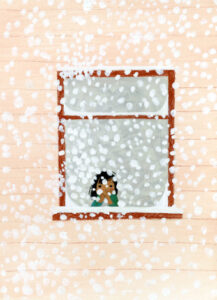 Like I said, I’ve read a lot of poetry books for kids about the seasons in my day. The good ones have some kind of a hook. Like Joyce Sidman tackling it with colors in Red Sings from Treetops or Jon J. Muth writing the poems entirely as haikus as in Hi, Koo! A Year in Seasons. But Fogliano doesn’t really have a hook, and so I approached the title with trepidation. No hook? You mean it was just going to be . . . poems?! It takes the courage of your convictions to do a poetry book for kids straight these days. And it’s not true that Fogliano didn’t have one ace up her sleeve. A lot of works of poetry start in January (when the year itself technically begins). Using a technique of highlighting random dates, this poet begins the book on March 20th, the first day of spring. A small hook, sure, but at least it’s something.
Like I said, I’ve read a lot of poetry books for kids about the seasons in my day. The good ones have some kind of a hook. Like Joyce Sidman tackling it with colors in Red Sings from Treetops or Jon J. Muth writing the poems entirely as haikus as in Hi, Koo! A Year in Seasons. But Fogliano doesn’t really have a hook, and so I approached the title with trepidation. No hook? You mean it was just going to be . . . poems?! It takes the courage of your convictions to do a poetry book for kids straight these days. And it’s not true that Fogliano didn’t have one ace up her sleeve. A lot of works of poetry start in January (when the year itself technically begins). Using a technique of highlighting random dates, this poet begins the book on March 20th, the first day of spring. A small hook, sure, but at least it’s something.
As for the poems themselves, I was impressed not just with the writing, but with Ms. Fogliano’s grasp of what each season actually entails. There are a LOT of cloudy days, rainy days, and generally blah days in this book. They don’t weigh down the narrative or really make it all that gloomy. You just end up experiencing precisely the same feeling you have when you’re living those days. This is the rare book that acknowledges that spring doesn’t immediately mean sunshine and 55-degree temperatures. There’s a lot of snow and some mud and a whole ton of rain. Listen to how she puts it, though: “today / the sky was too busy sulking to rain / and the sun was exhausted from trying / and everyone / it seemed / had decided / to wear their sadness / on the outside / and even the birds / and all their singing / sounded brokenhearted / inside of all that gray.” It really isn’t until June that things even out, and I respect that. All the seasons are like that. It’s great to watch.
As you might have noted, the poetry found in this book straddles a line between being child-friendly and introspective (the two aren’t mutually exclusive, but neither are they always natural pairs). I found myself noting line after line after line that I wanted to quote. Here’s a small taste for each season.
On Spring: “shivering and huddled close / the forever rushing daffodils / wished they had waited.”
On Summer: “if you ever stopped / to taste a blueberry / you would know / that it’s not really about the blue, at all.”
On Fall: “october please / get back in bed / your hands are cold / your nose is red / october please / go back to bed / your sneezing woke december.”
On Winter: “a gust of wind / blew by my nose / i think i will be frozen soon / this living room / (all cozy chairs and fireplace) / has some real explaining to do.”
Some books of children’s poetry lean heavily on the works of other poets. I won’t presume to name her influences but if the July 12th poem is any indication then William Carlos Williams might have had some influence here. And maybe e.e. cummings too (with all that mudlicious mud).
 When she was much younger it’s clear that author Julie Fogliano made some kind of a blood sacrifice to the God of Perfect Illustrator Pairings. How else to explain how she has managed to work alongside such artists as Erin E. Stead and now Julie Morstad? Morstad is no newbie to the field, of course. I’ve been a big fan of her for years, starting with her art for The Swing by Robert Louis Stevenson. Morstad’s great talent lies not necessarily in her waiflike black-eyed children, but rather in how she creates tone. Though there are plenty of sequences in this book of kids playing together or sharing food and soup, for the most part her characters go it alone. These poems are the contemplations of a young person with time and space and nature in spades. I don’t know that if I read Ms. Fogliano’s poetry without the art I would have picked up on that myself. Note too how cyclical the book is. The first poem is the last, sure as shooting, but so too is the person seen at both the beginning and the end. It’s the same kid wearing the same clothes, which makes a subtle implication that though a whole year has gone by, time is simply doubling back on itself. Not sure what to make of that one, frankly.
When she was much younger it’s clear that author Julie Fogliano made some kind of a blood sacrifice to the God of Perfect Illustrator Pairings. How else to explain how she has managed to work alongside such artists as Erin E. Stead and now Julie Morstad? Morstad is no newbie to the field, of course. I’ve been a big fan of her for years, starting with her art for The Swing by Robert Louis Stevenson. Morstad’s great talent lies not necessarily in her waiflike black-eyed children, but rather in how she creates tone. Though there are plenty of sequences in this book of kids playing together or sharing food and soup, for the most part her characters go it alone. These poems are the contemplations of a young person with time and space and nature in spades. I don’t know that if I read Ms. Fogliano’s poetry without the art I would have picked up on that myself. Note too how cyclical the book is. The first poem is the last, sure as shooting, but so too is the person seen at both the beginning and the end. It’s the same kid wearing the same clothes, which makes a subtle implication that though a whole year has gone by, time is simply doubling back on itself. Not sure what to make of that one, frankly.
With poetry, we have to play the game of answering what ages we think the poems are appropriate for. This book poses a bit of a challenge on that front. Some are younger, some definitely older. This mix will allow kids of all ages to take part in the fun, even as the book asks questions like whether or not there is a space between where things begin and things end “or just a slow and gentle fading”. Enticing to the eye but, more importantly almost, alluring to the brain as kids parse what Fogliano is trying to say, this is a book that has the potential (with the right teacher or parent) to convert the formerly unconvertible to the wonders of poetry itself. The truth of the matter is this: Fogliano and Morstad will make poets of us all.
On shelves now.
Source: Galley sent from publisher for review.
Like This? Then Try:
Professional Reviews:
Other Reviews:


By:
Betsy Bird,
on 1/18/2016
Blog:
A Fuse #8 Production
(
Login to Add to MyJacketFlap)
JacketFlap tags:
Reviews,
Best Books,
Candlewick,
African-American history,
picture book poetry,
Roxane Orgill,
2012 Caldecott contender,
African-American authors and illustrators,
African-American books,
Best Books of 2016,
Reviews 2016,
2016 poetry,
Francis Vallejo,
Add a tag
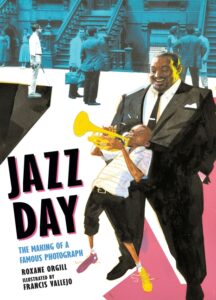 Jazz Day: The Making of a Famous Photograph
Jazz Day: The Making of a Famous Photograph
By Roxane Orgill
Illustrated by Francis Vallejo
Candlewick Press
$18.99
ISBN: 9780763669546
Ages 9-12
On shelves March 8th
Some books for kids have a hard road ahead of them. Here’s a secret. If you want a book to sell just oodles and oodles of copies to the general public, all you have to do is avoid writing in one of two specific genres: poetry and nonfiction. Even the best and brightest nonfiction books have a nasty tendency to fade from public memory too soon, and poetry only ever gets any notice during April a.k.a National Poetry Month. I say that, and yet there are some brave souls out there who will sometimes not just write poetry. Not just write nonfiction. They’ll write nonfiction-inspired poetry. It’s crazy! It’s like they care about the quality of the content more than make a bazillion dollars or something. The latest book to fall into this category is Jazz Day: The Making of a Famous Photograph by Roxane Orgill. Melding topics like jazz musicians and photography with history, poetry, and some truly keen art, this isn’t really like any other book on your shelves. I’m betting that that’s a good thing too.
It was sort of a crazy idea for a graphic designer / jazz buff to come up with. By 1958 jazz was a well-established, deeply American, musical genre. So why not try to get all the jazz greats, and maybe some up-and-comers, into a single photograph all together? The call went out but Art Kane (who really wasn’t a photographer himself) had no idea who would turn up. After all, they were going to take the picture at ten in the morning. That’s a time most jazz performers are fast asleep. Yet almost miraculously they came. Count Basie and Thelonious Monk. Maxine Sullivan and Dizzy Gillespie. Some of them were tired. Some were having a great time catching up with old friends. And after much cajoling on Kane’s part a photo was made. Fifty-seven musicians (fifty-eight if you count Willie “Lion” Smith just out of frame). Orgill tells the tale in poetry, with artist Francis Vallejo providing the art and life. Extensive backmatter consists of an Author’s Note, Biographies, a page on the photo and homages to it, Source Notes, and a Bibliography that includes Books, Articles, Audiovisual Material, and Websites.
Jazz is often compared to poetry. So giving this book too rigid a structure wouldn’t offer the right feel at all. I’m no poet. I wish I had a better appreciation for the art than I do. Yet even with my limited understanding of the style I found myself stopping when I read the poem “This Moment” written from the point of view of Eddie Locke, a drummer. It’s the kind of poem where it’s composed as a series of quatrains. The second and fourth lines of each stanza are repeated as the first and third lines of the next. It was fortunate for me that Orgill mentions in the back of the book that the poem is a pantoum. I’d never have come up with that term myself (I thought it was a sestina). Most of the poetry in the book isn’t really that formal. In fact, Orgill confesses that, “I write prose, not poetry. But this story demanded a sense of freedom, an intensity, and a conciseness that prose could not provide.” The result is that most of the poems are free verse, which I much preferred.
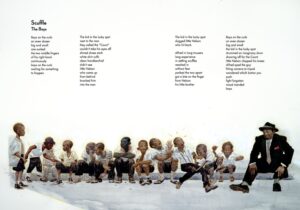 Did you know that when publishing a book for kids you’re not supposed to turn in your manuscript with an illustrator already attached? True fact. Editors like having the power to pair authors and artists together. To be honest, they have experience in this area and sometimes their intervention is sublime (sometimes it fails miserably too, but that’s a tale for another day). I’m afraid I don’t know what Candlewick editor saw Orgill’s manuscript and thought of Francis Vallejo as a potential illustrator. If I knew I’d kiss them. Detroit born Vallejo is making his debut with this book and you’d never know in a million years that he wasn’t a born and bred Harlemite. His style is perfect for this tale. As adept at comic style panels as he is acrylic and pastel jazz scenes, there’s life in this man’s art. It was born to accompany jazz. It’s also particularly interesting watching what he does with light. The very beginning of the book shows a sunrise coming up on a hot August day. As it rises, shadows make way. This play between light and shadow, between the heat of the photo shoot and the cool jazz clubs that occasionally make an appearance in the text, gives the book its heart. It’s playful and serious all at once so that when you lift the page that reveals the real photograph, that action produces a very real moment of awe.
Did you know that when publishing a book for kids you’re not supposed to turn in your manuscript with an illustrator already attached? True fact. Editors like having the power to pair authors and artists together. To be honest, they have experience in this area and sometimes their intervention is sublime (sometimes it fails miserably too, but that’s a tale for another day). I’m afraid I don’t know what Candlewick editor saw Orgill’s manuscript and thought of Francis Vallejo as a potential illustrator. If I knew I’d kiss them. Detroit born Vallejo is making his debut with this book and you’d never know in a million years that he wasn’t a born and bred Harlemite. His style is perfect for this tale. As adept at comic style panels as he is acrylic and pastel jazz scenes, there’s life in this man’s art. It was born to accompany jazz. It’s also particularly interesting watching what he does with light. The very beginning of the book shows a sunrise coming up on a hot August day. As it rises, shadows make way. This play between light and shadow, between the heat of the photo shoot and the cool jazz clubs that occasionally make an appearance in the text, gives the book its heart. It’s playful and serious all at once so that when you lift the page that reveals the real photograph, that action produces a very real moment of awe.
There’s been a lot of talk in the world of children’s literature lately about the research done on both works of fiction and nonfiction. Anytime you set your book in the past you have a responsibility to get the facts right. Part of what I love so much about Jazz Day is the extent of the research here. Orgill could easily have found a couple articles and books about the day of the photograph and stopped there. Instead, she writes that “Kane was by all accounts a wonderful storyteller, but one who did not always adhere to the facts. With the help of his son Jonathan Kane, I tried to set the story of the photograph straight.” Instructors who are teaching about primary sources in the schools could use this anecdote to show how reaching out to primary sources is something you need to do all the time. The rest of the backmatter (and it really is some of the most extensive I’ve ever seen) would be well worth showing to kids as well.
The question then becomes, whom is this book for? The complexity of the subject matter suggests that it’s meant for older kids. Those kids that might have a sense of some of the history (they might have heard what jazz is or who Duke Ellington was at some point in their travels). But would they read it for pleasure or as a kind of assigned reading? I don’t know. I certainly found it amusing enough, but I’m a 37-year-old woman. Not the target age range exactly. Yet I want to believe that there’s a fair amount of kid-friendly material here. Poems like “So Glad” and “quartet” may be about adults talking from an adult perspective, but Orgill cleverly livens the book up with the perspective of kids every step of the way. From the children sitting bored on the curb to a girl peering down from her window wishing the jazz men and photographer would just go away, kids get to give their two cents constantly. Read it more than once and you’ll begin to recognize some of them. Brothers Alfred and Nelson crop up more than a couple times too. Their mischief is just what the doctor ordered. With that in mind, it might be a good idea to have kids read different poems at different times. Save the more esoteric ones for later.
Jazz is hard to teach to kids. They know it’s important but it’s hard to make it human. There are always exceptions, though. For example, my 20-month-old is so obsessed with the book This Jazz Man by Karen Ehrhardt that he’ll have me read it to him a hundred times over. To my mind, that’s what this book is capable of, if at a much older level. It humanizes the players and can serve as a starting point for discussions, teaching units, you name it. These men and women are hot and tired and laughing and alive, if only at this moment in time. It’s a snapshot in both the literal and figurative sense. It’ll take some work to get it into the right hands, I suspect, but in the end it’s worth it. Jazz isn’t some weird otherworldly language. It’s people. These people. Now the kids in the book, and the kids reading this book, have a chance to get to know them.
On shelves March 8th.
Source: Galley sent from publisher for review.
Like This? Then Try:
Professional Reviews:

 Fun Fact: The American Library Association does not currently give an award specifically to great works of children’s book poetry. Is not that strange? When I first discovered this to be true, I was perplexed. I’ve always been a bit of a rube when it comes to the poetic form. Placing stresses on syllables and knowing what constitutes a sestina and all that. Of course even without its own award specifically, poetry can win the Newbery or the Caldecott. Yet too often when it happens it’s in the form of a verse novel or its sort of pooh-poohed for its win. Remember when Last Stop on Market Street won the Newbery and folks were arguing that it was the first picture book to do so since A Visit to William’s Blake’s Inn couldn’t possibly be considered a picture book because it was poetry? None of this is to say that poetry doesn’t win Newberys (as recently as 2011 Dark Emperor and Other Poems of the Night by Joyce Sidman won an Honor) but aside from the month of April (Poetry Month a.k.a. the only time the 811 section of the public library is sucked dry) poetry doesn’t get a lot of attention.
Fun Fact: The American Library Association does not currently give an award specifically to great works of children’s book poetry. Is not that strange? When I first discovered this to be true, I was perplexed. I’ve always been a bit of a rube when it comes to the poetic form. Placing stresses on syllables and knowing what constitutes a sestina and all that. Of course even without its own award specifically, poetry can win the Newbery or the Caldecott. Yet too often when it happens it’s in the form of a verse novel or its sort of pooh-poohed for its win. Remember when Last Stop on Market Street won the Newbery and folks were arguing that it was the first picture book to do so since A Visit to William’s Blake’s Inn couldn’t possibly be considered a picture book because it was poetry? None of this is to say that poetry doesn’t win Newberys (as recently as 2011 Dark Emperor and Other Poems of the Night by Joyce Sidman won an Honor) but aside from the month of April (Poetry Month a.k.a. the only time the 811 section of the public library is sucked dry) poetry doesn’t get a lot of attention.

























Wonderful list with some titles I have yet to explore. I would have to add Joyce Sidman’s lovely book, Before Morning, and Irene Latham’s whimsical book of poems inspired by the farmer’s market, Fresh Delicious. Loved Wet Cement and When Green Becomes Tomatoes.
I also loved When Green Becomes Tomatoes, Wet Cement & Slickety Quick (as well as Brown’s verse novel, To Stay Alive).
Some other titles I enjoyed: Irene Latham’s When the Sun Shines on Antarctica, David Harrison’s Now You See Them, Now You Don’t and Mirror Mirror by Marilyn Singer.
It is strange that ALA does not give a children’s poetry award, but NCTE does. Many of the above titles are on the latest list plus the Verse Novel List. These titles and all the previous years can be found at: http://www.ncte.org/awards/poetry
I pondered including Before Morning, but figured it slotted better on the upcoming picture book list. Fear not! It has not been forgotten.